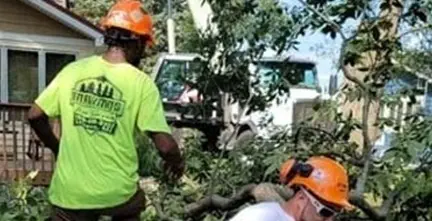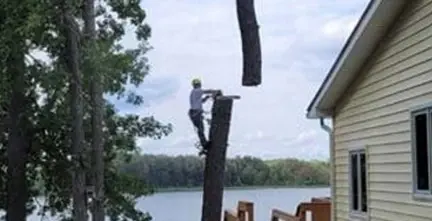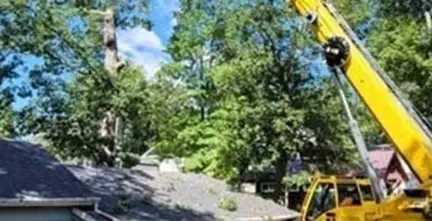Why Tree Risk Assessment Matters in 2025
After a storm, you may find a branch across your driveway or notice a tree leaning more than usual. Tree hazards are more than an eyesore. According to the National Storm Damage Center, falling trees and limbs cause over $1 billion in property damage annually in the United States. Risks are increasing as severe weather events become more common. The real danger lies in what you do, or do not do, when you first notice the signs.
This guide walks you step by step through a certified tree risk checklist. It explains current hazards, why assessments matter more than ever, and helps you decide when to call a professional. By the end, you will know how to keep your property, loved ones, and community safe without guesswork.
The Reality of Tree Risk in 2025: Insights and Trends

Rapid Weather Changes Increase Tree Failures
2024 and early 2025 brought record-setting winds, heavy rainfall, droughts, and heatwaves. These conditions stress trees even in well-established neighborhoods. Urban and suburban trees face compacted soils, root damage from utility work, and unpredictable moisture levels.
Arborist reports throughout the Midwest and Northeast show an increase in hidden internal decay and root rot, especially following new construction, aggressive landscaping, or repeated drought-flood cycles. A 2025 study by the International Society of Arboriculture (ISA) cites a 27% rise in hazard tree removals compared to figures from three years prior.
Real-World Expertise
Most dangerous trees look harmless until the moment they fail. Hidden root damage is often a bigger threat than visible trunk cracks. Cutting-edge tools like resistographs, sonic tomography, and drone inspections are now common among top tree care professionals, revealing threats invisible from the ground.
What Most People Get Wrong About Tree Risk
- Thinking green equals safe: Healthy-looking leaves can hide severe internal decay or root rot.
- Waiting for obvious symptoms: By the time branches die off, the tree may already be unstable.
- DIY climbs or quick trims: Untrained homeowners can cause more harm or miss hidden dangers, risking injury.
- Ignoring roots after construction: Soil compaction or grading work can suffocate roots and destabilize mature trees.
- Believing insurance covers all risks: Policies often exclude damage from negligence if the risk was observable.
How to avoid these mistakes: Start a proactive checklist walkaround every season. Call a professional if something seems off, especially after storms or construction.
Spotting Tree Hazards: How to Handle Assessment the Smart Way
Step 1: Do a Ground-Level Walkaround
Use this checklist on each mature or valuable tree:
- Are there large, dead, or broken branches?
- Do you see detached or hanging limbs?
- Are there cracks or splits in the trunk or at limb joints?
- Has the tree developed a sudden lean or shifted recently?
- Do you see mushrooms or conks at the base, indicating decay?
- Are roots exposed, is soil heaving, or are new roots appearing at the surface?
- Can you spot trunk cavities, soft spots, or holes?
- Is bark peeling or are there visible wounds?
- Are leaves yellowing or is the canopy thinning outside normal seasonal change?
- Is there sawdust, sap oozing, or insect activity on trunk or branches?
- Has there been construction or excavation in the root zone recently?
- Are there burn marks, bark splits, or missing bark after storms?
- Has the tree dropped branches unexpectedly in the past?
If you answer yes to any of these, move to the next step.
Step 2: Assess the Severity
- Immediate Risks: Cracks in the main trunk, roots lifting from the ground, lean greater than 15 degrees, large dead branches over structures or sidewalks, storm or lightning damage.
- Moderate Risks: Fungi at the base, bark wounds, canopy thinning, history of minor limb loss.
- Low Risks: Small dead twigs, light pruning wounds, healthy regrowth.
Step 3: When to Call an Arborist
Call a certified professional if you see:
- Major trunk or root cracks
- Mushrooms or rot at the tree base
- Sudden leaning or shifting roots
- Large dead limbs over driveways, roofs, or power lines
- Signs of recent ground disturbance near mature trees
- Past branch failures in high-traffic areas
Step 4: Quick-Action Safety Table
| Issue | DIY Safe? | Call a Pro? |
| Small, low branch with clean break | Yes | Optional |
| Branch near wires, roof, street | No | Yes |
| Trunk splits, fungi at base | No | Yes |
| Roots exposed or lifting | No | Yes |
| Tilted tree after storm | No | Yes, immediately |
| Sudden canopy dieback | No | Yes |
Step 5: Keep Good Records
Photograph concerns, note when you first saw an issue, and gather details before calling. This documentation helps professionals recommend the best solution and supports any insurance claim.
Pro Tip: Seasonal checkups prevent most urgent removals. If you cannot see high canopies, call a professional. Drones and sensors are now common for complete, non-invasive risk assessments.
Questions People Keep Asking About Tree Hazard Assessment
How do I know if my tree is truly dangerous?
Red flags include sudden leans, visible root lifting, mushrooms or rot at the trunk base, major cracks, or large dead limbs over structures and walking areas. Even one of these signs means it is time to consult a professional.
Can I do my own tree risk assessment?
You can walk around and spot major warning signs using a checklist, but only a certified arborist can diagnose hidden decay, internal fractures, or root problems without risking safety.
When is the best time to have trees checked for hazards?
Late winter or early spring before full leaf-out is ideal. After storms or nearby digging or construction, schedule an assessment right away. Any time you notice a new issue is the right time to check.
Do healthy-looking trees ever fail unexpectedly?
Yes. Trees can store damage for years before failing during a storm. Externally healthy trees can have internal defects that only advanced tools or careful inspection will reveal.
What does a professional hazard assessment include?
A certified arborist will inspect all visible parts of the tree for structural weakness, check roots and soil, use tools like resistographs or sonic sensors if needed, and provide a written report with clear next steps.
Will my insurance cover damage from a hazardous tree?
Usually only if you could not have reasonably foreseen the risk. If damage occurs and it is proven the hazard was obvious or neglected, the claim could be denied. Regular assessments protect your assets and your claim.
How often should I schedule a professional tree risk assessment?
Every three years is ideal for most properties, more often after major storms, drought, construction, or if trees are mature or near valuable structures.
What should I look for in a certified arborist or tree service?
Check for ISA or TCIA credentials, current insurance, references, and experience with advanced assessment tools. A reputable professional will document everything and explain options clearly.
Wrapping Up: What You Should Do Next
Regular tree risk assessment is no longer optional for homeowners. Start with a checklist after every major storm or construction project. Walk your main trees every spring and fall. If you spot signs of risk, keep records and consult a certified arborist who uses the latest tools and clear inspection reports.
Keeping your property safe is about observation, action, and trust in experienced professionals. A single assessment can prevent costly damage and provide peace of mind.
If you are unsure or need a second opinion, reach out to us for a comprehensive hazard assessment or give us a call (269) 371-5449.



